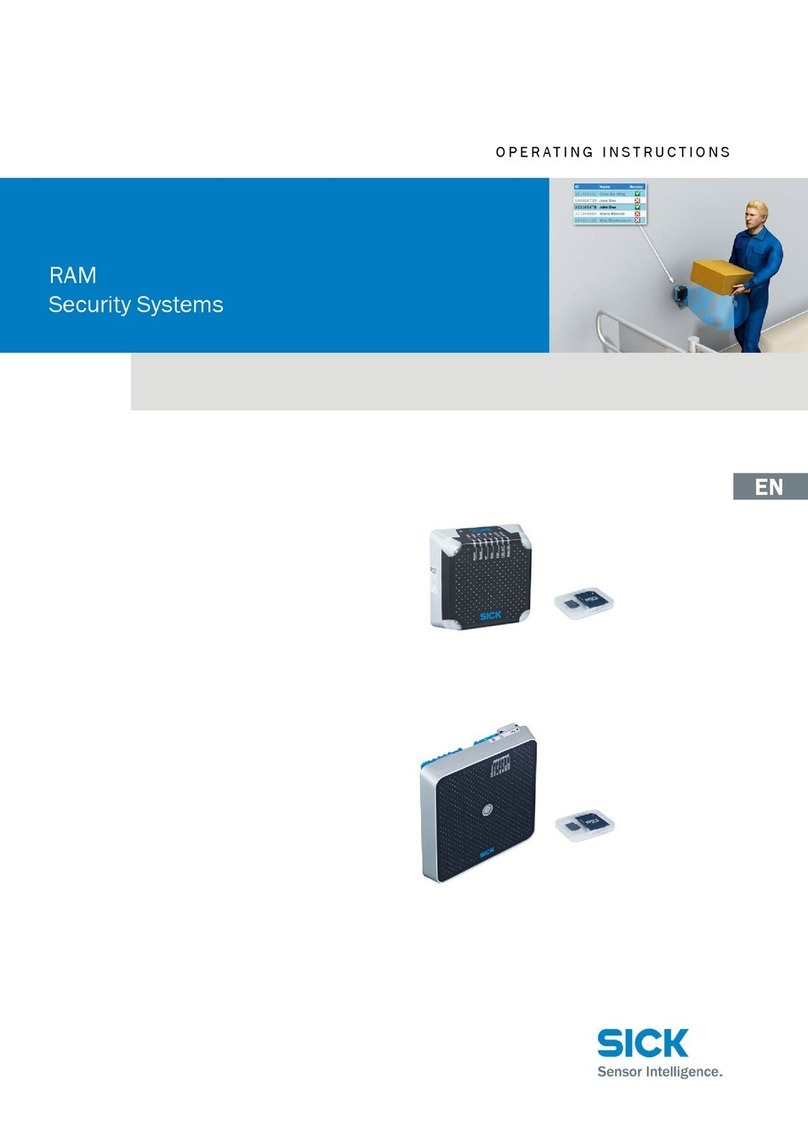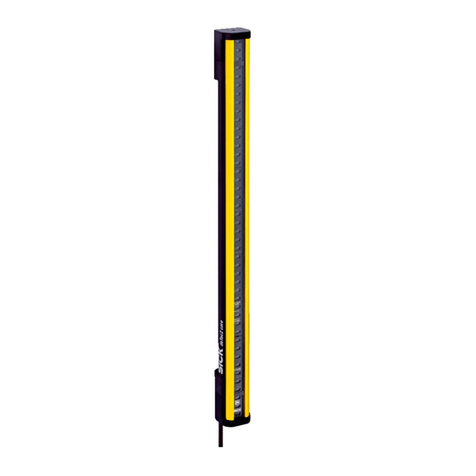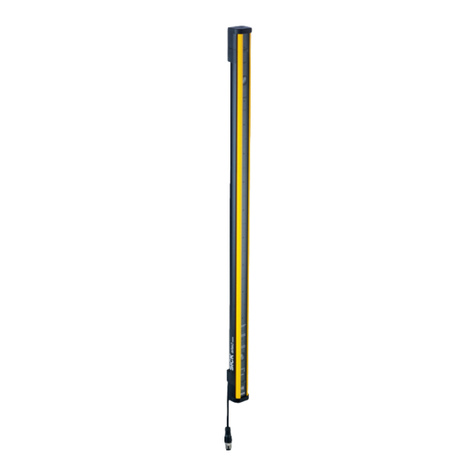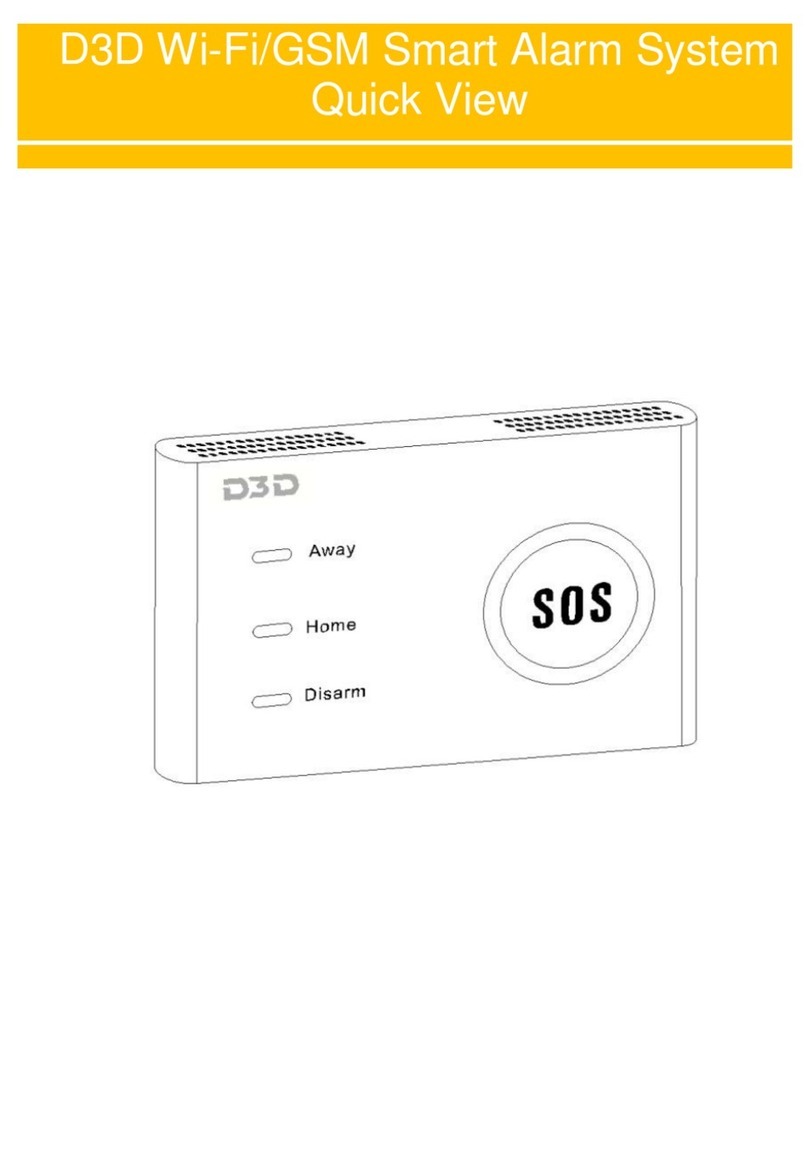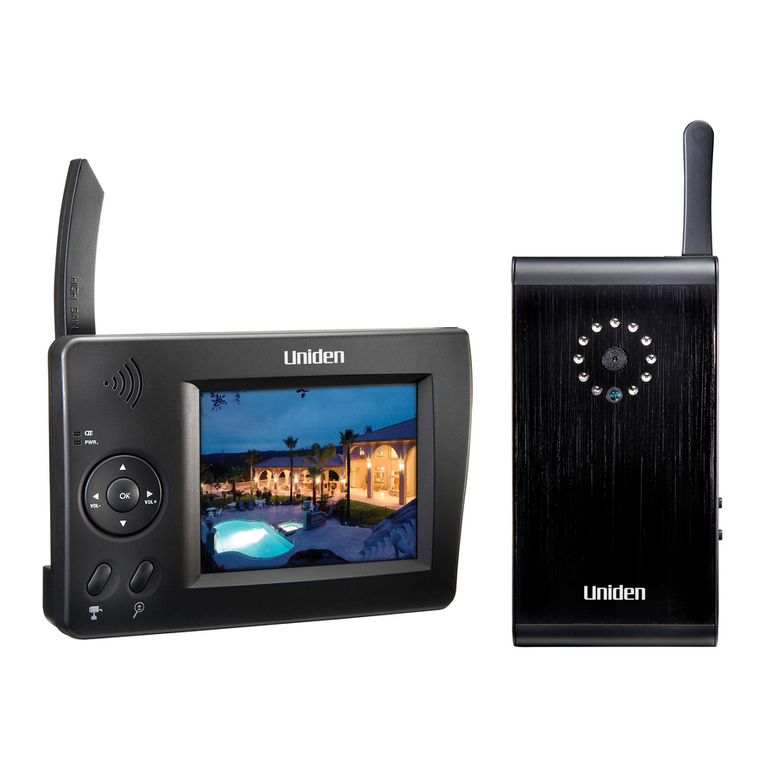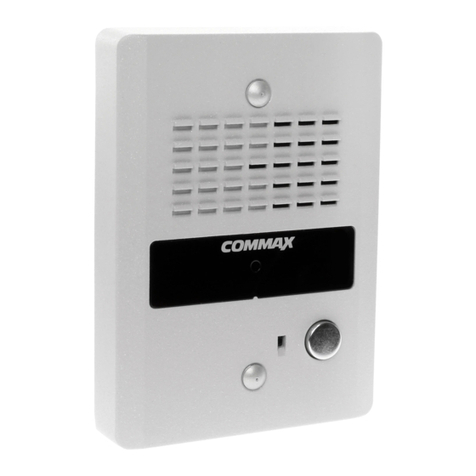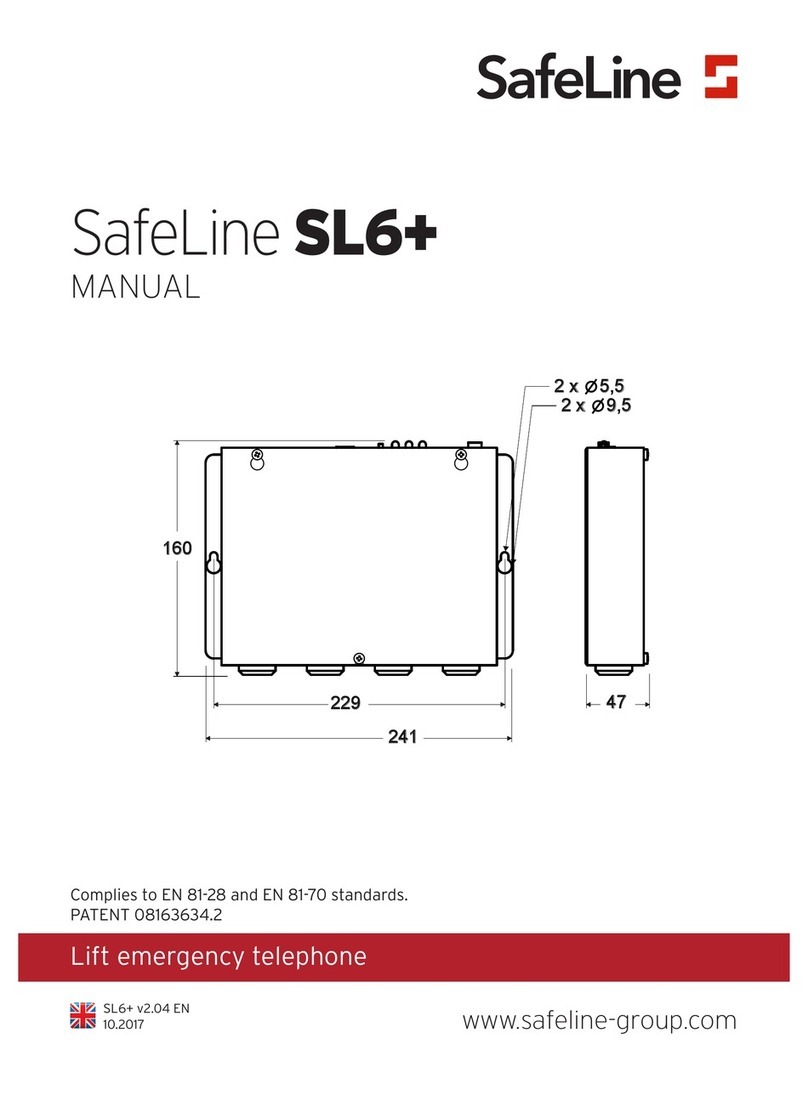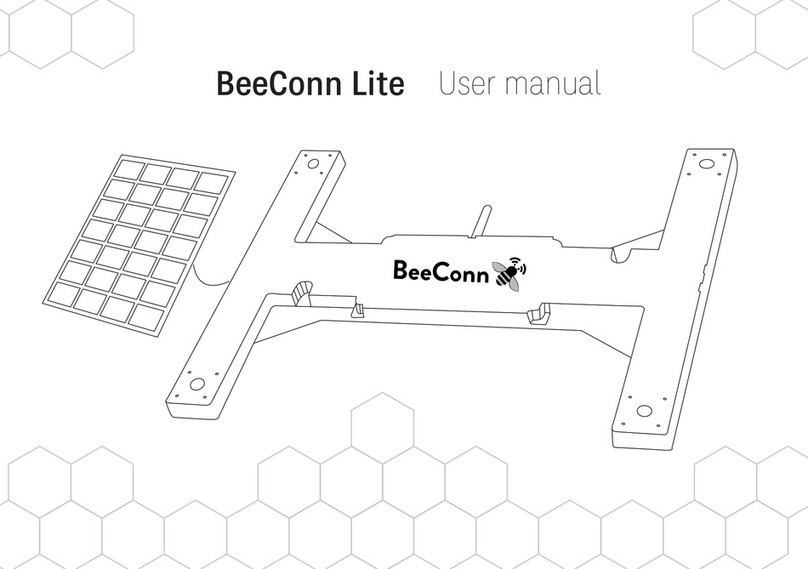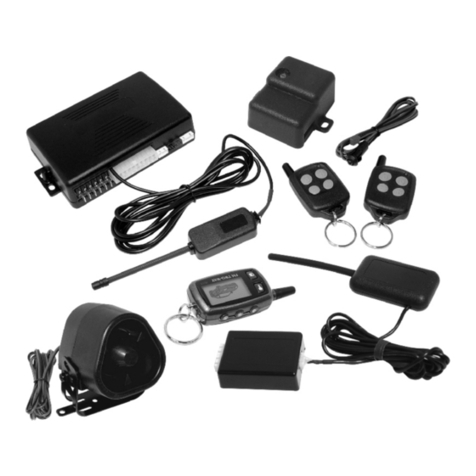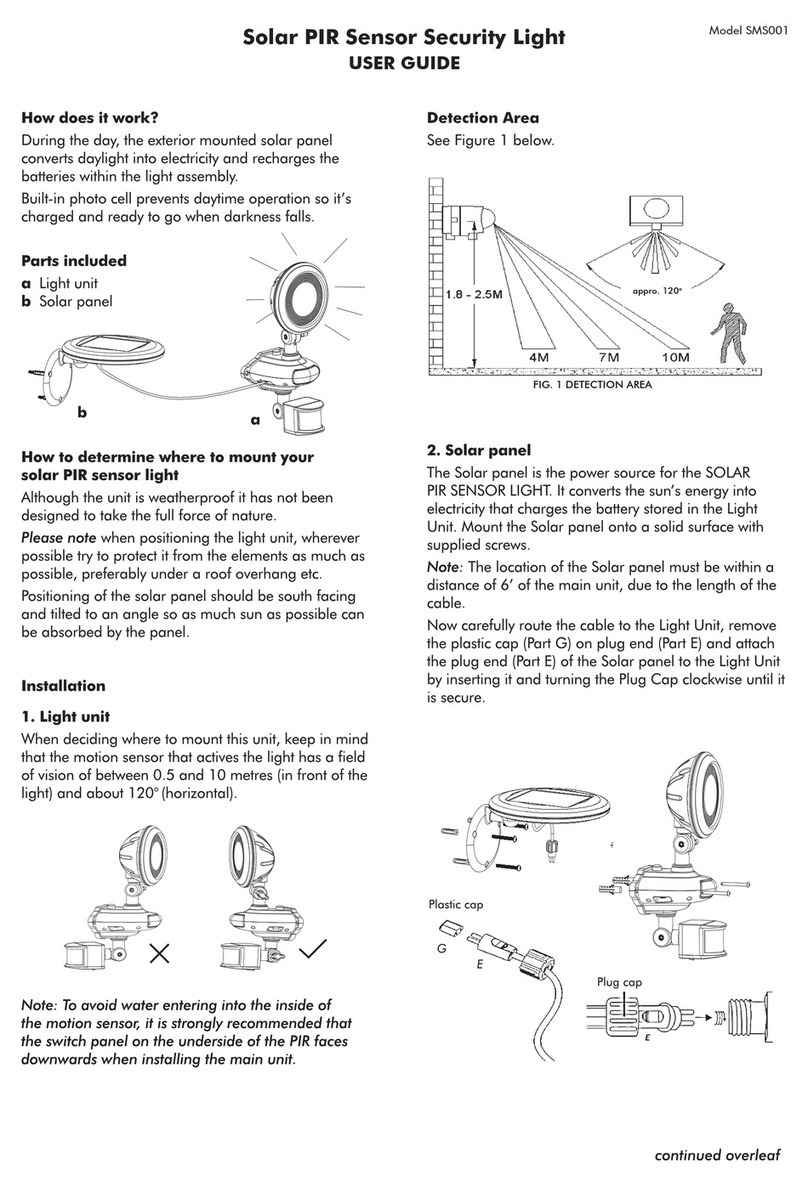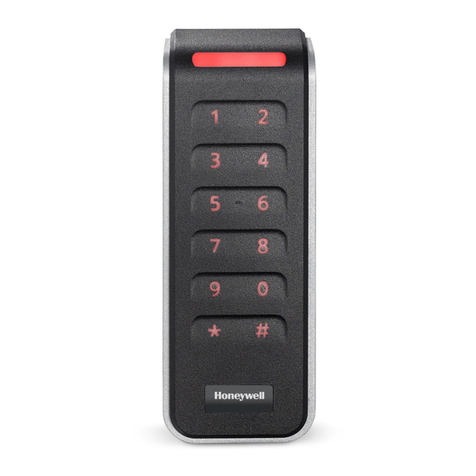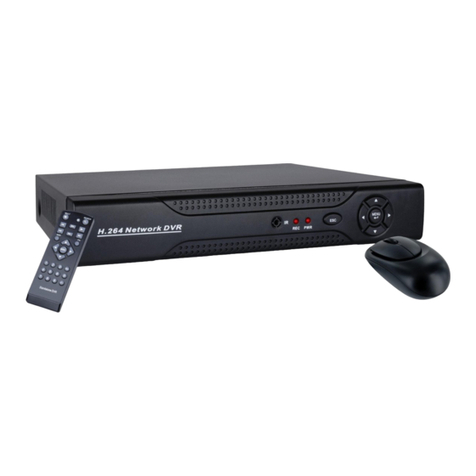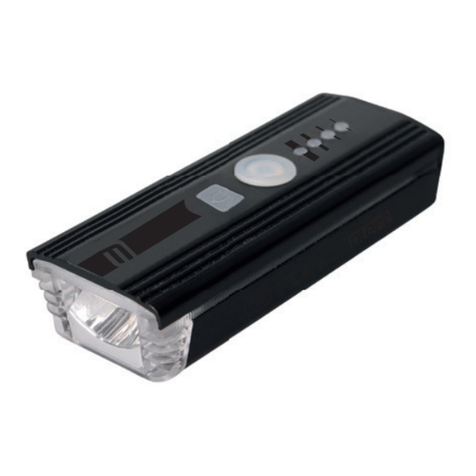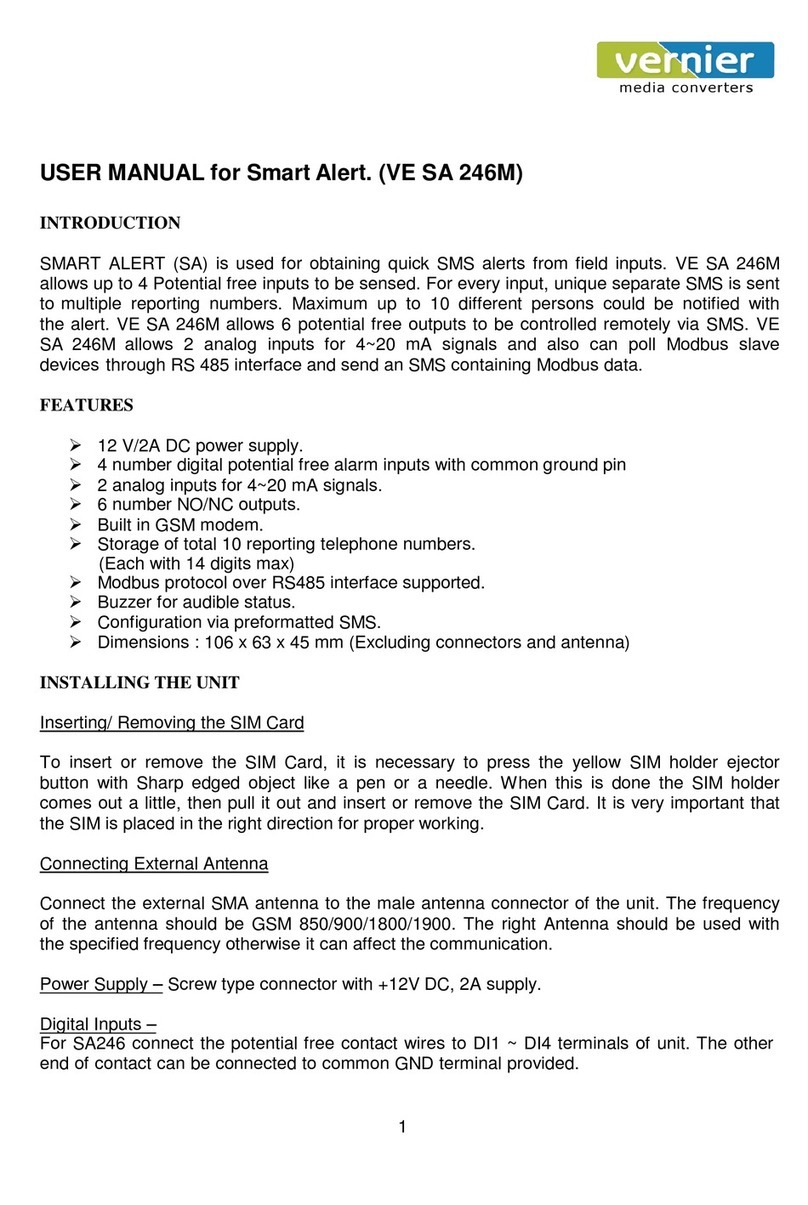SICK deTec4 Core User manual

OPERATING INSTRUCTIONS
deTec4 Ex
Safety light curtain

Described product
deTec4 Ex
Manufacturer
SICK AG
Erwin-Sick-Str. 1
79183 Waldkirch
Germany
Legal information
This work is protected by copyright. Any rights derived from the copyright shall be
reserved for SICK AG. Reproduction of this document or parts of this document is only
permissible within the limits of the legal determination of Copyright Law. Any modifica‐
tion, abridgment or translation of this document is prohibited without the express writ‐
ten permission of SICK AG.
The trademarks stated in this document are the property of their respective owner.
© SICK AG. All rights reserved.
Original document
This document is an original document of SICK AG.
2O P E R A T I N G I N S T R U C T I O N S | deTec4 Ex 8022883/2019-03-07 | SICK
Subject to change without notice

Contents
1 About this document........................................................................ 7
1.1 Scope......................................................................................................... 7
1.2 Target groups and structure of these operating instructions................ 7
1.3 Additional information.............................................................................. 8
1.4 Symbols and document conventions...................................................... 8
2 Safety information............................................................................ 10
2.1 General safety notes................................................................................ 10
2.2 Correct use................................................................................................ 11
2.3 Requirements for the qualification of personnel.................................... 13
3 Product description........................................................................... 15
3.1 Structure and function............................................................................. 15
3.2 Product characteristics............................................................................ 16
3.2.1 Device overview....................................................................... 16
3.2.2 Automatic calibration of the protective field width................ 16
3.2.3 Beam coding............................................................................ 16
3.2.4 Alignment aid........................................................................... 17
3.2.5 Restart interlock...................................................................... 17
3.2.6 External device monitoring (EDM).......................................... 17
3.2.7 Application diagnostic output................................................. 17
3.2.8 System plug.............................................................................. 17
3.2.9 Flexible control cabinet cabling and status indication on
both sides................................................................................. 18
3.2.10 Status indicators...................................................................... 18
3.3 Example applications............................................................................... 21
4 Project planning................................................................................ 23
4.1 Manufacturer of the machine.................................................................. 23
4.2 Operator of the machine.......................................................................... 23
4.3 Design........................................................................................................ 23
4.3.1 Scanning range and protective field width............................. 24
4.3.2 Minimum distance from the hazardous point....................... 25
4.3.3 Minimum distance to reflective surfaces............................... 27
4.3.4 Protection against interference from systems in close prox‐
imity to each other................................................................... 29
4.4 Integration in electrical control................................................................ 31
4.4.1 Restart interlock...................................................................... 34
4.4.2 External device monitoring (EDM).......................................... 35
4.4.3 Application diagnostic output................................................. 36
4.4.4 Connection of sender and receiver........................................ 36
4.4.5 Laser alignment aid................................................................. 37
4.4.6 Connection diagrams.............................................................. 38
4.5 Testing plan............................................................................................... 39
CONTENTS
8022883/2019-03-07 | SICK O P E R A T I N G I N S T R U C T I O N S | deTec4 Ex 3
Subject to change without notice

4.5.1 Test rod check.......................................................................... 39
4.5.2 Visual check of the machine and the protective device........ 42
5 Mounting............................................................................................. 43
5.1 Safety......................................................................................................... 43
5.2 Unpacking.................................................................................................. 44
5.3 Mounting the system plug........................................................................ 44
5.4 Mount the safety light curtain in the explosion-proof enclosure (only
if the safety light curtain is used in North America)............................... 45
5.5 Mount the optional cable gland............................................................... 47
5.6 Mount the handles to the cover of the explosion-proof enclosure........ 47
5.7 Installation................................................................................................ 48
5.7.1 Mounting the safety light curtain without alignment
bracket...................................................................................... 50
5.7.2 Mounting the safety light curtain with alignment bracket.... 52
6 Electrical installation........................................................................ 56
6.1 Safety......................................................................................................... 56
6.2 System connection (flying leads, 8-wire)................................................. 58
7 Configuration..................................................................................... 60
7.1 Overview.................................................................................................... 60
7.2 Factory settings......................................................................................... 60
7.2.1 Reset to factory settings......................................................... 61
7.3 Configuration mode.................................................................................. 62
7.4 Configuring beam coding......................................................................... 62
7.5 Configuring the restart interlock.............................................................. 63
7.6 Configuring external device monitoring (EDM)....................................... 64
7.7 Configuring application diagnostic output.............................................. 64
7.8 Status indication on both sides............................................................... 65
8 Commissioning.................................................................................. 66
8.1 Safety......................................................................................................... 66
8.2 Overview.................................................................................................... 67
8.3 Switching on.............................................................................................. 67
8.4 Sender and receiver alignment................................................................ 68
8.4.1 Aligning the sender and receiver............................................ 68
8.4.2 Alignment with the alignment bracket................................... 70
8.4.3 Indication of the alignment quality......................................... 71
8.5 Check during commissioning and modifications.................................... 72
9 Operation............................................................................................ 73
9.1 Safety......................................................................................................... 73
9.2 Regular thorough check........................................................................... 73
9.3 LEDs........................................................................................................... 73
10 Maintenance...................................................................................... 76
CONTENTS
4O P E R A T I N G I N S T R U C T I O N S | deTec4 Ex 8022883/2019-03-07 | SICK
Subject to change without notice

10.1 safety......................................................................................................... 76
10.2 Regular cleaning....................................................................................... 76
10.3 Regular thorough check........................................................................... 78
11 Troubleshooting................................................................................. 79
11.1 Safety......................................................................................................... 79
11.2 Diagnostic LEDs........................................................................................ 79
11.2.1 Indications when switching on................................................ 79
11.2.2 Status indication...................................................................... 81
11.2.3 Fault indicators........................................................................ 83
12 Decommissioning............................................................................. 88
12.1 Protection of the environment................................................................. 88
12.2 Disposal..................................................................................................... 88
13 Technical data.................................................................................... 89
13.1 Data sheet................................................................................................. 89
13.2 Response time.......................................................................................... 92
13.3 Power consumption.................................................................................. 92
13.4 Table of weights........................................................................................ 92
13.5 Dimensional drawings.............................................................................. 93
14 Ordering information........................................................................ 98
14.1 Scope of delivery....................................................................................... 98
14.2 Ordering information deTec4 Ex.............................................................. 98
15 Accessories........................................................................................ 99
15.1 Brackets.................................................................................................... 99
15.2 Mounting accessories.............................................................................. 100
15.3 Connectors................................................................................................ 100
15.4 Alignment aid............................................................................................ 100
15.5 Deflector mirrors....................................................................................... 100
15.5.1 Function and use..................................................................... 100
15.5.2 Mounting.................................................................................. 101
15.5.3 Change in scanning range using deflector mirrors................ 101
15.5.4 Deflector mirror PNS75 - ordering information...................... 102
15.5.5 Deflector mirror PSN125 - ordering information................... 102
15.6 Mirror columns.......................................................................................... 102
15.7 Device columns......................................................................................... 102
15.8 Cleaning agent.......................................................................................... 103
15.9 Test rods.................................................................................................... 103
16 Annex.................................................................................................. 104
16.1 Compliance with EU directives................................................................. 104
16.2 Note on specified standards.................................................................... 105
16.3 Checklist for initial commissioning and commissioning........................ 106
CONTENTS
8022883/2019-03-07 | SICK O P E R A T I N G I N S T R U C T I O N S | deTec4 Ex 5
Subject to change without notice

17 List of figures..................................................................................... 107
18 List of tables....................................................................................... 109
CONTENTS
6O P E R A T I N G I N S T R U C T I O N S | deTec4 Ex 8022883/2019-03-07 | SICK
Subject to change without notice

1 About this document
These operating instructions contain information required during the life cycle of the
safety light curtain.
These operating instructions are available to all those who work with the safety light
curtain.
Please read these operating instructions carefully and make sure that you understand
the content fully before working with the safety light curtain.
1.1 Scope
These operating instructions only apply to the deTec4 Ex safety light curtain with one of
the following type label entries in the “Operating Instructions” field:
•8022831
This document is included with the following SICK part numbers (this document in all
available language versions):
8022831
1.2 Target groups and structure of these operating instructions
These operating instructions are intended for the following target groups: Project devel‐
opers (planners, developers, designers), installers, electricians, safety experts (e.g., CE
authorized representatives, compliance officers, persons who test and approve the
application), operators, and maintenance personnel.
The structure of these operating instructions is based on the life cycle phases of the
safety light curtain: Project planning, mounting, electrical installation, commissioning,
operation, and maintenance.
In many applications, the target groups are assigned as follows to the manufacturer
and the organization operating the machine in which the safety light curtain is inte‐
grated:
Area of responsibility Target group Special chapters of these operating instruc‐
tions 1)
Manufacturer Project developers
(planners, developers,
designers)
"Project planning", page 23
"Configuration", page 60
"Technical data", page 89
"Accessories", page 99
Installers "Mounting", page 43
Electricians "Electrical installation", page 56
Safety specialists "Project planning", page 23
"Configuration", page 60
"Commissioning", page 66
"Technical data", page 89
"Checklist for initial commissioning and com‐
missioning", page 106
Operating company Operator "Operation", page 73
"Troubleshooting", page 79
Maintenance person‐
nel
"Maintenance", page 76
"Troubleshooting", page 79
"Ordering information", page 98
1) Chapters not listed here are intended for all target groups. All target groups must take into account the
safety and warning instructions of the complete operating instructions!
ABOUT THIS DOCUMENT 1
8022883/2019-03-07 | SICK O P E R A T I N G I N S T R U C T I O N S | deTec4 Ex 7
Subject to change without notice

In other applications, the operating organization is also the manufacturer of the equip‐
ment with the corresponding allocation of the target groups.
1.3 Additional information
www.sick.com
The following information is available on the Internet:
•This document in other languages
•Data sheets and application examples
•CAD data and dimensional drawings
•Certificates (e.g. EU declaration of conformity)
•Guide for Safe Machinery Six steps to a safe machine
1.4 Symbols and document conventions
The following symbols and conventions are used in this document:
Safety notes and other notes
DANGER
Indicates a situation presenting imminent danger, which will lead to death or serious
injuries if not prevented.
WARNING
Indicates a situation presenting possible danger, which may lead to death or serious
injuries if not prevented.
CAUTION
Indicates a situation presenting possible danger, which may lead to moderate or minor
injuries if not prevented.
NOTICE
Indicates a situation presenting possible danger, which may lead to property damage if
not prevented.
NOTE
Indicates useful tips and recommendations.
Instructions to action
bThe arrow denotes instructions to action.
1. The sequence of instructions for action is numbered.
2. Follow the order in which the numbered instructions are given.
✓The check mark denotes the result of an instruction.
LED symbols
These symbols indicate the status of an LED:
oThe LED is off.
ÖThe LED is flashing.
OThe LED is illuminated continuously.
1 ABOUT THIS DOCUMENT
8O P E R A T I N G I N S T R U C T I O N S | deTec4 Ex 8022883/2019-03-07 | SICK
Subject to change without notice

Sender and receiver
These symbols indicate the sender and receiver of the device:
sThe symbol indicates the sender.
rThe symbol indicates the receiver.
ABOUT THIS DOCUMENT 1
8022883/2019-03-07 | SICK O P E R A T I N G I N S T R U C T I O N S | deTec4 Ex 9
Subject to change without notice

2 Safety information
This chapter contains information on general safety for the safety light curtain.
More safety information about specific usage situations of the safety light curtain is
available in the respective chapters.
2.1 General safety notes
DANGER
Hazard due to lack of effectiveness of the protective device
In the case of non-compliance, it is possible that the dangerous state of the machine
may not be stopped or not stopped in a timely manner.
bPlease read this document carefully and make sure that you understand the con‐
tent fully before working with the device.
bFollow all safety notes in this document.
CAUTION
Laser class 1
LASER
1
Figure 1: Laser class 1
This device has been classified in accordance with the following standards:
•IEC 60825-1:2007/EN 60825-1:2007
•IEC 60825-1:2014/EN 60825-1:2014
•21 CFR 1040.10 and 1040.11, except for deviations pursuant to Laser Notice
No. 50 dated 2007-06-24
The laser is eye-safe. Looking directly into the laser may cause temporary impairments.
The outlet opening of the laser radiation is located in the sender, see figure 4,
page 18. The laser is only active when the laser alignment aid is switched on.
Laser identification is located on the rear of the sender.
bComply with the latest version of the applicable provisions on laser protection.
CAUTION
If any operating or adjusting devices other than those specified in this document are
used or other methods are employed, this can lead to dangerous exposure to radiation.
bOnly use the operating or adjusting devices specified in this document.
bOnly follow the methods specified in this document.
bDo not open the housing, except for the purposes of the installation and mainte‐
nance work specified in these operating instructions.
2 SAFETY INFORMATION
10 O P E R A T I N G I N S T R U C T I O N S | deTec4 Ex 8022883/2019-03-07 | SICK
Subject to change without notice

WARNING
Risk of ineffectiveness of the protective device
Please observe the following information to ensure that you are using the deTec4 Ex
safety light curtain safely and correctly.
bNational and international regulations and guidelines must be observed when
mounting, using, and commissioning electrical devices as well as when carrying
out regular technical inspections in explosion-hazardous areas. Article 500 of the
National Electrical Code and ATEX Directive 2014/34/EU shall apply in particular.
Manufacturers and operators of machines using safety light curtains are responsi‐
ble for ensuring that all applicable safety regulations and guidelines are complied
with.
bThese operating instructions must be made available to the operator of the
machine on which the safety light curtain is used. Qualified safety personnel must
instruct the operator in how to use the device. The operator must also be directed
to read and follow the operating instructions.
DANGER
Risk of ignition
Failure to observe this instruction can result in a risk of ignition from potential sparking.
bEnsure that only accessories that are approved for explosion-hazardous areas are
used.
NOTE
SICK provides more information about the following explosion-proof connections:
•Joint between glass and cover
•Joint between cover and explosion-proof enclosure
2.2 Correct use
Overview
The deTec4 Ex safety light curtain is an electro-sensitive protective device (ESPE) and is
suitable for the following applications:
•Hazardous point protection
•Access protection
•Hazardous area protection
The deTec4 Ex safety light curtain is suitable for use in enclosed spaces only. It has
UL/cUL certification for the following hazardous areas defined in the National Electrical
Code® and Canadian Electrical Code®:
•Class I, groups C, D
•Class II, groups E, F, G
•Class III
The deTec4 Ex safety light curtain also complies with these standards: EN
60079-0:2012/A11:2013/IEC 60079-0 Edition 6.0, EN 60079-1:2014/ IEC 60079-1
Edition 7.0, EN 60079-31:2014/IEC 60079-31 Edition 2.0 and is certified for the fol‐
lowing hazardous areas:
•X II 2 G Ex db IIB T6
•X II 2 D Ex tb IIIC T56°C Db IP6X
SAFETY INFORMATION 2
8022883/2019-03-07 | SICK O P E R A T I N G I N S T R U C T I O N S | deTec4 Ex 11
Subject to change without notice

•Ex db IIB T6
•Ex tb IIIC T56°C Db IP6X
DEMKO 14 ATEX 1315X
IECEx UL 14.0034X
The deTec4 Ex safety light curtain does not emit any substances which hinder paint
coating, any volatile silicones or any solid parts or materials into its surroundings.
The deTec4 Ex safety light curtain must only be used within the limits of the prescribed
and specified technical data and operating conditions at all times.
Any instance of improper use, incorrect modification, or manipulation of the deTec4 Ex
safety light curtain shall void any warranty provided by SICK AG; furthermore, SICK AG
shall not accept any responsibility or liability for any resulting damage and consequen‐
tial damage.
Important information
DANGER
Hazard due to lack of effectiveness of the protective device
Persons and parts of the body to be protected may not be recognized in case of non-
observance.
The safety light curtain works as an indirect protective measure and cannot provide pro‐
tection from parts thrown out nor from emitted radiation. Transparent objects are not
detected.
bOnly use the safety light curtain as an indirect protective measure.
DANGER
Risk of ignition
Failure to observe this information could result in a risk of ignition.
bThe sender, receiver, and cables delivered with the safety light curtain are not
explosion-proof. The person purchasing, assembling, and using the safety light cur‐
tain is responsible for fitting the cables in suitable explosion-proof conduits and/or
cable glands to ensure the integrity of the system.
bThe type label on each individual explosion-proof enclosure contains information
on the device’s hazardous area class and group. Every device that penetrates the
explosion-proof enclosure must be suitable for the environment in which the explo‐
sion-proof enclosure is installed with regard to its hazardous area class and group
or zone.
DANGER
Risk of ignition
Failure to observe this information could result in a risk of ignition.
Only if the device is used outside North America:
bA cable gland must be mounted.
bThe cable gland must be certified for d and tb environments.
2 SAFETY INFORMATION
12 O P E R A T I N G I N S T R U C T I O N S | deTec4 Ex 8022883/2019-03-07 | SICK
Subject to change without notice

DANGER
Risk of ignition
Failure to observe this information could result in a risk of ignition.
Only if the device is used in North America:
bAny conduit openings that are not in use must be sealed. Sealing fittings must turn
at least five (5) full revolutions and be at least 3.175 mm thick (1/8 of an inch).
bConduit sealing fittings must be applied in each installed conduit run (located a
maximum of 457 mm (18 inches) away from the explosion-proof enclosure) in
order to comply with the provisions of the most recent version of the National Elec‐
trical Code, Article 501.15 and/or 502.15, and all other applicable regulations.
Foreseeable misuse
Among others, the deTec4 Ex safety light curtain is not suitable for the following appli‐
cations:
•Outdoors
•Underwater
•At altitudes over 3,000 m above sea level
•In environments with enhanced ionizing radiation
2.3 Requirements for the qualification of personnel
The safety light curtain must be configured, installed, connected, commissioned and
serviced only by qualified safety personnel.
Project planning
For project planning, a person is considered competent when he/she has expertise and
experience in the selection and use of protective devices on machines and is familiar
with the relevant technical rules and national work safety regulations.
Mechanical mounting
For mechanical mounting, a person is considered competent when he/she has the
expertise and experience in the relevant field and is sufficiently familiar with the appli‐
cation of the protective device on the machine that he/she can assess its operational
safety status.
Electrical installation
For electrical installation, a person is considered competent when he/she has the
expertise and experience in the relevant field and is sufficiently familiar with the appli‐
cation of the protective device on the machine that he/she can assess its operational
safety status.
Configuration
For configuration, a person is considered competent when he/she has the expertise
and experience in the relevant field and is sufficiently familiar with the application of
the protective device on the machine that he/she can assess its work safety aspects.
Commissioning
For commissioning, a person is considered competent when he/she has the expertise
and experience in the relevant field and is sufficiently familiar with the application of
the protective device on the machine that he/she can assess its operational safety sta‐
tus.
SAFETY INFORMATION 2
8022883/2019-03-07 | SICK O P E R A T I N G I N S T R U C T I O N S | deTec4 Ex 13
Subject to change without notice

Operation and maintenance
For operation and maintenance, a person is considered competent when he/she has
the expertise and experience in the relevant field and is sufficiently familiar with the
application of the protective device on the machine and has been instructed by the
machine operator in its operation.
Maintenance and thorough checks may only be carried out by qualified and trained per‐
sonnel, who are familiar with the regulations and provisions for potentially explosive
atmospheres, in particular with:
•Ignition protection types
•Installation regulations
•Regulations on distances which must be complied with.
An operator must clean the safety light curtain. Additional information for the operator
of the machine: see "Operation", page 73, and see "Regular cleaning", page 76.
2 SAFETY INFORMATION
14 O P E R A T I N G I N S T R U C T I O N S | deTec4 Ex 8022883/2019-03-07 | SICK
Subject to change without notice

3 Product description
This chapter provides information on the operation of the safety light curtain and shows
examples of its range of use.
3.1 Structure and function
Overview
The deTec4 Ex safety light curtain is an electro-sensitive protective device (ESPE) con‐
sisting of a sender and receiver.
A series of parallel infrared light beams form a protective field between sender and
receiver that protects the hazardous area (hazardous point, access, and hazardous
area protection). When one or more light beams are completely interrupted, the safety
light curtain reports the interruption in the light path to the secure output signal switch‐
ing devices (OSSDs) by a signal change. The machine or its control must safely analyze
the signals (for example using a safe control or safety relays) and stop the dangerous
state.
Sender and receiver automatically synchronize themselves optically. An electrical con‐
nection between both components is not required, but is advantageous.
Figure 2: Sender and receiver
Protective field height
The protective field height indicates the range within which the test rod belonging to the
safety light curtain is reliably detected.
Protective field width
The protective field width is the dimension of the light path between sender and
receiver. The maximum protective field width is limited by the scanning range.
PRODUCT DESCRIPTION 3
8022883/2019-03-07 | SICK O P E R A T I N G I N S T R U C T I O N S | deTec4 Ex 15
Subject to change without notice

Resolution
The resolution describes the size of the smallest object detected by the safety light cur‐
tain in the protective field. The resolution corresponds to the diameter of the test rod
belonging to the safety light curtain.
The safety light curtain has a resolution of 30 mm. This resolution provides hand pro‐
tection.
Scanning range
The scanning range is the maximum protective field width.
The scanning range is reduced by using deflector mirrors.
Further topics
•"Flexible control cabinet cabling and status indication on both sides", page 18
•"Data sheet", page 89
•"Deflector mirrors", page 100
3.2 Product characteristics
3.2.1 Device overview
!
§
"
$
Figure 3: Device overview
!Sender or receiver
"System plug
§Terminal compartment
$System connection
3.2.2 Automatic calibration of the protective field width
When switched on, the safety light curtain automatically calibrates to the protective
field width.
3.2.3 Beam coding.
Depending on its configuration, the safety light curtain operates with 1 of 3 beam cod‐
ings: uncoded, code 1 or code 2. The beam coding “uncoded” allows for particularly
short response times. In order to avoid mutual interference between 2 neighboring
safety light curtains, one can be operated with code 1 and the other with code 2.
3 PRODUCT DESCRIPTION
16 O P E R A T I N G I N S T R U C T I O N S | deTec4 Ex 8022883/2019-03-07 | SICK
Subject to change without notice

3.2.4 Alignment aid
A laser alignment aid is installed in the sender of the safety light curtain. The laser
alignment aid can be switched on to perform a simple alignment of the sender.
Diagnostic LEDs are installed in the receiver of the safety light curtain. For a simple
alignment of the receiver, diagnostic LEDs 1, 2, 3 and 4 indicate the alignment quality
once the safety light curtain has been switched on.
Diagnostic LEDs 5 and 6 light up if the topmost beam (far from system plug) is synchro‐
nized. Diagnostic LEDs 7 and 8 light up if the bottommost beam (near system plug) is
synchronized.
3.2.5 Restart interlock
The safety light curtain has an integrated restart interlock. The function can be config‐
ured during commissioning.
A restart interlock prevents the machine from starting again once the protective device
has been triggered. The operator must first press a reset pushbutton to allow the pro‐
tective device to resume its monitoring function. The operator can then restart the
machine.
3.2.6 External device monitoring (EDM)
The safety light curtain has integrated external device monitoring. The function can be
configured during commissioning.
The external device monitoring (EDM) monitors the status of downstream contactors.
In order to use the external device monitoring, positively guided contactors must be
used to switch off the machine. If the auxiliary contacts of the positively guided contac‐
tors are connected to the external device monitoring, the external device monitoring
checks whether the contactors drop off when the OSSDs are switched off.
3.2.7 Application diagnostic output
The safety light curtain has an application diagnostic output on the system connection.
Depending on the configuration, the application diagnostic output signals a certain sta‐
tus of the safety light curtain, e.g. if the reset pushbutton must be engaged or if there is
a weak signal at the receiver.
For a signal of the safety light curtain to be displayed, a light can be connected to the
application diagnostic output or the signal can be transmitted to the machine con‐
troller.
3.2.8 System plug
Overview
The following system plugs are available for the safety light curtain:
•SP1 system plug
The system plugs are available in the following versions:
•System plug (flying leads, 8-wire)
The following functions are available depending on the system plug used:
•Beam coding
•Restart interlock
•External device monitoring (EDM)
•Application diagnostic output
PRODUCT DESCRIPTION 3
8022883/2019-03-07 | SICK O P E R A T I N G I N S T R U C T I O N S | deTec4 Ex 17
Subject to change without notice

3.2.9 Flexible control cabinet cabling and status indication on both sides
The safety light curtain can be connected to the control cabinet in different ways as
required:
•Separate connecting cables for sender and receiver
•Separate connecting cables for sender and receiver with connection in the control
cabinet
The OSSD status and the status of the protective field are indicated via LEDs on the
sender and receiver when the following applies:
•The sender and receiver are connected to one another in the control cabinet
If the sender and receiver are not connected to each other, this status information is
only indicated at the receiver.
Further topics
•"Connection diagrams", page 38
3.2.10 Status indicators
Overview
The sender and receiver LEDs indicate the operational status of the safety light curtain.
Sender indicators
!
"
§
Figure 4: Sender indicators
The sender has one laser alignment aid and at least two light emitting diodes, which
indicate the operational status:
3 PRODUCT DESCRIPTION
18 O P E R A T I N G I N S T R U C T I O N S | deTec4 Ex 8022883/2019-03-07 | SICK
Subject to change without notice

Position LED color Function Labeling
!Red/yellow/green Field indicator 1);
shows the status of
the protective field
and additional infor‐
mation about the sta‐
tus display
–
"– Laser alignment aid –
§Red/yellow/green Status indicator STATE
1) Safety light curtains with protective field height > 300 mm have several light emitting diodes for the field
indicator.
Receiver indicators
!
§
"
1234
5 6 7 8
Figure 5: Receiver indicators
At least ten light emitting diodes on the receiver indicate the operational status:
Position LED color Function Labeling
!Red/yellow/green Field indicator 1);
shows the status of
the protective field
and additional infor‐
mation about the sta‐
tus display
–
"Blue/red/yellow/white Diagnostics 1, 2, 3, 4, 5, 6, 7, 8
§Red/green OSSD status OSSD
1) Safety light curtains with protective field height > 300 mm have several light emitting diodes for the field
indicator.
Further topics
•"Diagnostic LEDs", page 79
3.2.10.1 Indication of diagnostic LEDs
Table 1: Colors and their meaning
Color Color Meaning
OWhite Configuration status
PRODUCT DESCRIPTION 3
8022883/2019-03-07 | SICK O P E R A T I N G I N S T R U C T I O N S | deTec4 Ex 19
Subject to change without notice

Color Color Meaning
OBlue Alignment quality
ORed Fault indicator
OYellow Warning
o LED off. Ö LED flashes. O LED illuminates.
Table 2: Indication of the configuration status
Diagnostic LEDs Color Configuration
1O White External device monitoring (EDM) is config‐
ured.
2O White Reserved
3O White Beam coding is configured.
4O White Restart interlock is configured.
5O White Reserved
6O White Reserved
7O White Reserved
8O White Reserved
o LED off. Ö LED flashes. O LED illuminates.
Table 3: Indication of the alignment quality
Diagnostic LEDs Color Meaning
1 ... 4 O Blue Indication of the alignment quality.
If only one diagnostic LED lights up, the align‐
ment is insufficient. If all 4 diagnostic LEDs
light up, the alignment is excellent.
5, 6 O Blue The topmost beam (far from system plug) is
synchronized.
7, 8 O Blue The bottommost beam (near system plug) is
synchronized.
o LED off. Ö LED flashes. O LED illuminates.
Table 4: Fault indicator
Diagnostic LEDs Color Meaning
1 ... 8 O Red A red illuminated diagnostic LED signals the
function at which an error has occurred.
1 ... 8 Ö Red A red flashing diagnostic LED signals the rea‐
son for the error.
o LED off. Ö LED flashes. O LED illuminates.
Example: If diagnostic LED 1 lights up red and diagnostic LED 5 flashes red, there is an
EDM error.
Table 5: Warnings
Diagnostics LED Color Meaning
1 ... 8 O Yellow A yellow illuminated diagnostic LED signals
which function is affected.
1 ... 8 Ö Yellow A yellow flashing diagnostic LED signals the
reason for the warning.
o LED off. Ö LED flashes. O LED illuminates.
3 PRODUCT DESCRIPTION
20 O P E R A T I N G I N S T R U C T I O N S | deTec4 Ex 8022883/2019-03-07 | SICK
Subject to change without notice
Other manuals for deTec4 Core
16
Table of contents
Other SICK Security System manuals
